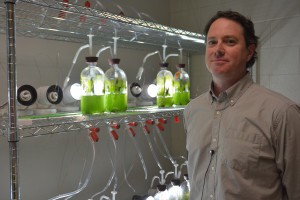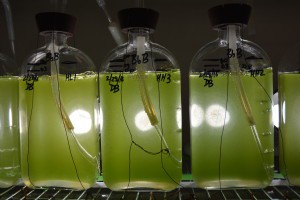Scientists from Texas A&M may have discovered a way to coax algae into making larger amounts of oil. The team discovered an enzyme responsible for making hydrocarbons that could in turn increase the amount of oil algae produces improving the algae to biofuel process. The green algae strain researched was Botryococcus braunii, and the study was published in the current issue of Nature Communications and led by Dr. Tim Devarenne, an AgriLife Research biochemist at Texas A&M.

Dr. Timothy Devarenne studies the biofuel properties of a common green microalga called Botryococcus braunii in his lab at Texas A&M University. Photo Credit: Kathleen Phillips
“The interesting thing about this alga is that it produces large amounts of liquid hydrocarbons, which can be used to make fuels such as gasoline, kerosene and diesel fuel,” Devarenne told AgriLife Today, a Texas A&M campus publication. “And these liquid hydrocarbons made by the alga are currently found in petroleum deposits, so we are already using them as a source to generate fuel.”
“Botryococcus is found pretty much everywhere in the world except for seawater,” he added. “It’s very cosmopolitan. It grows in freshwater or brackish water. It’s found in almost all ponds and lakes around the world. It’s been found in every continent except Antarctica, and it grows from mountain to desert climates.”
The goal of the research was to discover how to get algae to make more oil and so the team looked at how Botryococcus braunii makes the liquid hydrocarbons — what genes and pathways are involved — with the idea of manipulating the genes to express specific traits.

This common green microalga called Botryococcus braunii is found everywhere in the world except in sea water. It has potential to be used as a biofuel. Photo Credit: Kathleen Phillips
The team found an interesting gene called lycopaoctaene synthase, or LOS and the enzyme encoded by the LOS gene is able to initiate the production of oil. The research team then began to pick apart the pathway and found that the LOS enzyme is essentially “promiscuous” in that it is capable of mixing several different substances, or substrates, to make different products. Using this enzyme, the team was able to make several different hydrocarbon-like products. While Devarenne said they are a ways from producing a commercial product, their next step is to finish deciphering the pathway.

